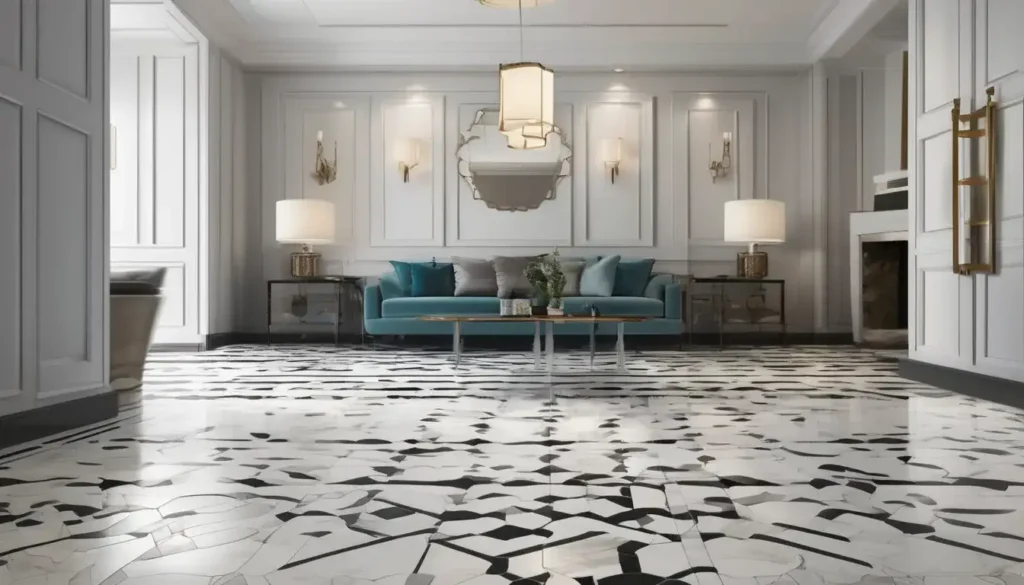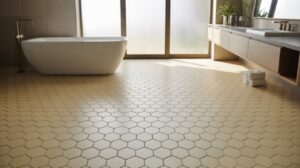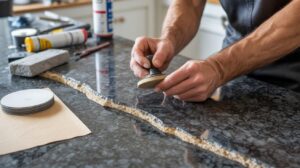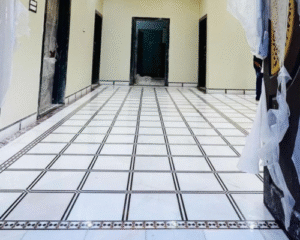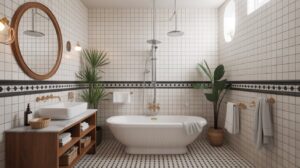Top 10 Unique Kitchen Tile to Wood Floor Transition Ideas
Kitchen tile to wood floor transition ideas are essential for creating a cohesive and visually stunning kitchen design. A seamless transition not only bridges the gap between two distinct materials but also enhances the overall flow of your space. With the right approach, combining tile and wood flooring can create a balanced blend of durability, elegance, and practicality, perfectly suited for modern kitchens. Incorporating tile and wood together allows homeowners to enjoy the best of both worlds tiles for their resilience and moisture resistance, and wood for its warmth and timeless appeal. Thoughtfully designed transitions elevate the aesthetic appeal while maintaining functionality, turning a simple kitchen floor into a standout feature of your home.
Mastering the Essentials of Floor Transitions
Kitchen tile to wood floor transition ideas are crucial for creating a harmonious and functional kitchen space. A well-planned transition ensures smooth navigation between different areas of your kitchen, making it easy to move seamlessly from tile to wood flooring without interruption. Beyond functionality, these transitions prevent tripping hazards, offering a safe and visually appealing flow that enhances the overall design of your kitchen.
Table of Contents
ToggleWhy Floor Transitions Matter in Kitchen Design
Floor transitions play a vital role in defining the character of a kitchen. They not only separate distinct flooring materials but also unify the space by blending practicality with aesthetic appeal. When executed professionally, transitions elevate your kitchen’s design, providing both durability and a polished look. At SF Marble & Granite, we prioritize creating transitions that merge form and function, ensuring your kitchen remains both stylish and safe.
Key Factors to Consider When Designing Floor Transitions
- Material Compatibility: Choosing the right materials is essential for a flawless transition. For example, tiles should complement the tone and texture of the wood to maintain a cohesive look.
- Durability and Maintenance: High-traffic kitchens require transitions that can withstand wear and tear. Opt for materials and designs that are easy to maintain and built to last.
- Aesthetic Cohesion: Your kitchen floor should reflect your design preferences. Seamless transitions, whether subtle or bold, should enhance the overall visual harmony of your space.
Tools and Techniques for a Perfect Floor Transition
Professionally crafted floor transitions require the use of high-quality tools and materials. Transition strips, reducers, and adhesives ensure a flawless and secure connection between tile and wood. We combine advanced techniques with premium materials to achieve stunning results that last for years. Trusting experts for your floor transitions guarantees precision, durability, and a finish that complements your kitchen’s design.
How Do I Tile a Transitional Floor?
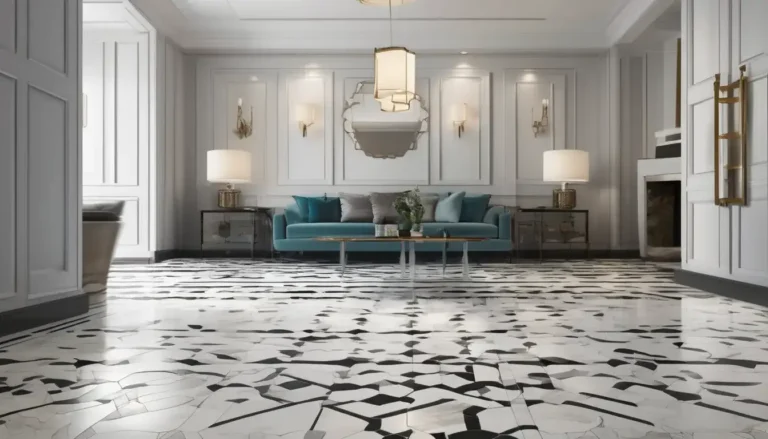
Creating a seamless transition between tile and wood flooring is an essential aspect of modern kitchen design. By following the right steps and avoiding common mistakes, you can achieve a flawless look that enhances both functionality and visual appeal. These kitchen tile to wood floor transition ideas will help you execute a professional-quality transition that blends durability and style.
Step-by-Step Guide to Installing Tile and Wood Floor Transitions
Measure the Gap and Level the Subfloor
Begin by measuring the space between the tile and wood sections to ensure the correct fit for the transition. Check the subfloor for any height discrepancies uneven surfaces can lead to gaps or instability. Use leveling compounds if necessary to create a uniform base for both materials.
Select the Right Transition Material
Choose a transition material that complements both the tile and wood in terms of design and durability. Options like metal transition strips, grout lines, or decorative inlays work well. The choice depends on your desired aesthetic whether you want a subtle blend or a bold statement.
Secure Tiles and Wood Flooring Edges with Proper Adhesives
Use professional-grade adhesives to firmly secure the edges of both flooring materials. This step is crucial to maintaining a durable and stable connection over time. Ensure that the adhesive is appropriate for the specific materials used to prevent future issues.
Finish with Seamless Edging or a Decorative Border
Complete the transition with a finishing touch. Seamless edging or a decorative border not only ties the two materials together but also adds a polished look. Metal strips or wood trim can provide a sleek and durable finish, while mosaic inlays create a unique and artistic statement.
Common Mistakes to Avoid
While designing and installing floor transitions, it’s essential to steer clear of these common errors:
- Uneven Edges Between Tile and Wood
Misaligned edges can disrupt the visual flow and create tripping hazards. Always double-check measurements and leveling during installation. - Choosing Incompatible Colors or Materials
The tile and wood should harmonize with your kitchen’s overall design. Clashing tones or textures can detract from the cohesive look you’re aiming for. - Using Weak Adhesives That Cause Long-Term Issues
Subpar adhesives can lead to separation over time. Invest in high-quality materials to ensure a long-lasting, secure bond between the tile and wood.
By following these guidelines and incorporating professional expertise, you can elevate your kitchen’s style and functionality. With the right kitchen tile to wood floor transition ideas, your flooring can seamlessly blend practicality and design, creating a space that stands out for all the right reasons.
Enhancing Kitchen Floor Transitions for Aesthetic Appeal
The way you transition between tile and wood flooring can significantly influence your kitchen’s overall look and feel. Thoughtful design choices ensure that these transitions don’t just serve a functional purpose but also enhance the aesthetic appeal of your space. Whether you prefer clean, modern lines or creative patterns, these kitchen tile to wood floor transition ideas will inspire you to achieve a harmonious and stylish kitchen. If you’re also considering granite repair to complement your kitchen’s new look, our team at SF Marble & Granite offers expert services to restore and maintain your granite surfaces.
Color Coordination and Contrast Ideas
Complementary Color Schemes for Seamless Transitions
Using complementary colors between your tile and wood flooring ensures a harmonious look. For example, pairing light oak wood with soft, neutral-toned tiles creates a cohesive and inviting space.
Bold Contrasts to Highlight the Transition Area
If you want the transition to be a design statement, opt for bold contrasts. Dark tiles against light wood flooring (or vice versa) can define the boundary and add a dramatic touch to your kitchen design.
Materials That Complement Each Other
Best Tile Finishes for Pairing with Wood Flooring
Matte or textured tiles often pair well with wood, as they mimic natural surfaces and create a seamless aesthetic. Glossy tiles can also work, but are best suited for kitchens with a modern or high-end look.
How to Choose Wood Tones That Enhance Tile Patterns
The wood tone you select should either complement or contrast the tile pattern for the best effect. For intricate tile patterns, opt for subtle wood tones to avoid overwhelming the design. Conversely, bold wood tones pair beautifully with simpler tile styles, creating a balanced yet striking appearance.
By selecting the right styles, colors, and materials, your floor transitions can become an integral part of your kitchen’s design. These kitchen tile to wood floor transition ideas showcase how blending functionality with aesthetics can elevate the overall appeal of your space. For expert assistance with premium materials and flawless installations, trust SF Marble & Granite to bring your vision to life.
Top 10 Innovative Kitchen Tile to Wood Floor Transition Ideas
When it comes to kitchen tile to wood floor transition ideas, achieving a seamless blend of aesthetics and functionality is key. The way you transition between tile and wood can greatly influence the overall feel of your kitchen, setting the tone for the entire space. From bold contrasts to intricate designs, these ideas will inspire you to create a kitchen that’s both beautiful and functional.
Pair Wood with an Ornate Patterned Tile
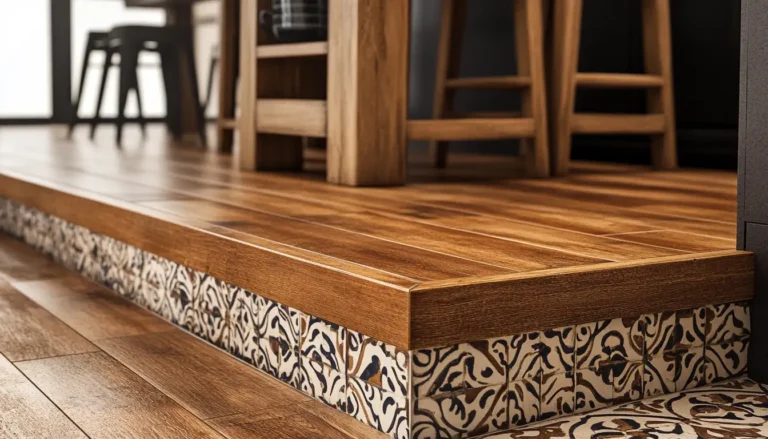
A fantastic way to merge wood with tile is by pairing a richly textured or ornate patterned tile with the warmth of wood flooring. The contrast between the intricate design of the tile and the natural texture of the wood creates a striking transition. This approach is perfect for adding personality and elegance to your kitchen while still keeping the flow of materials natural and complementary. For an added touch of luxury and timeless appeal, consider exploring marble slabs near me to introduce refined stone accents that blend beautifully with both wood and tile elements.
Ceramic Tile to Wood Floor Transition
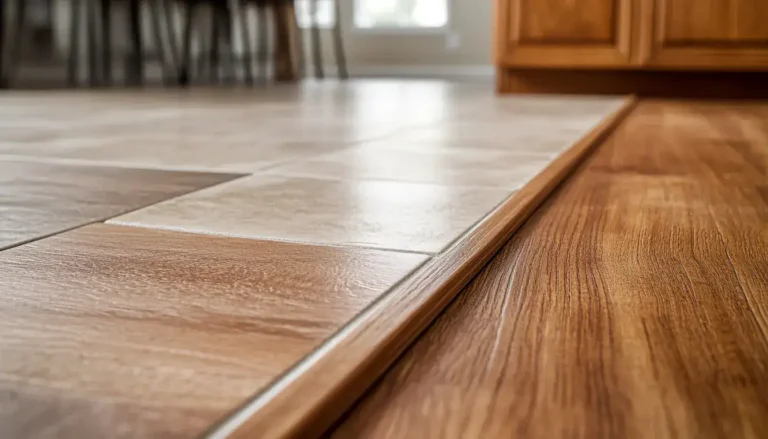
Ceramic tiles are an extremely flexible choice, boasting a range of colors, textures, and designs to complement the organic feel of wood flooring seamlessly. Opting for subtle tones or bold patterns for a seamless transition is key; ceramic tiles come in all sorts of forms to fit the bill!
The Diagonal Cut
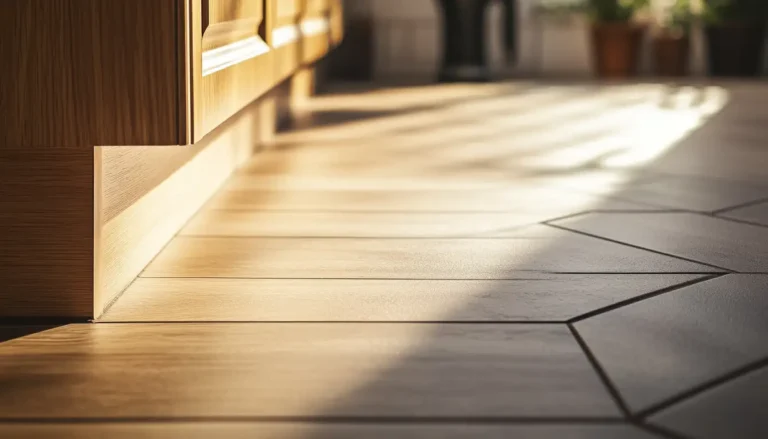
A diagonal cut in the tile flooring creates a visual flow that leads the eye naturally into the wood flooring. This unique angle adds depth and interest to your kitchen, making the transition between materials feel more dynamic. Diagonal cuts work well in modern kitchens and create a contemporary, geometric aesthetic that’s both eye-catching and sophisticated.
The Mosaic Transition
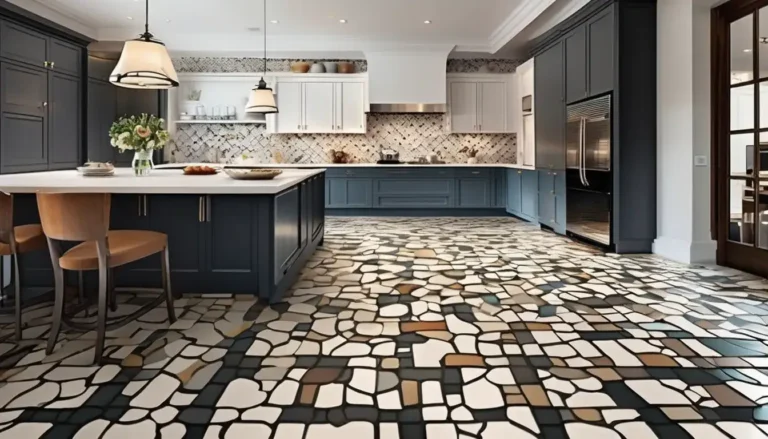
Mosaics are a creative and colorful way to transition between wood and tile. Whether it’s a patterned mosaic border or a full mosaic section, the beauty of these intricate designs adds a layer of texture and style that stands out. The mix of tile colors and designs in the mosaic blends beautifully with wood, offering a perfect balance of texture, color, and movement in the transition.
The Zigzag Pattern
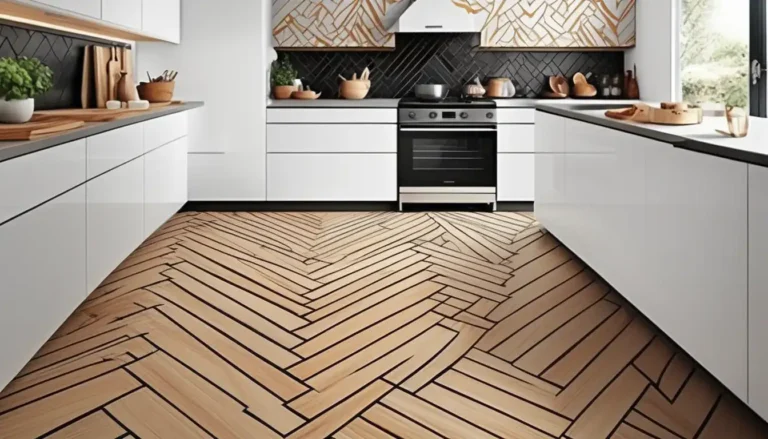
For a playful and creative transition, consider using a zigzag pattern. This style can create a bold visual impact, making the transition from tile to wood a standout feature. Whether the zigzag is subtle or bold, it brings a dynamic element to the floor, providing an unexpected twist that adds charm and personality to your kitchen.
The Bold Contrast
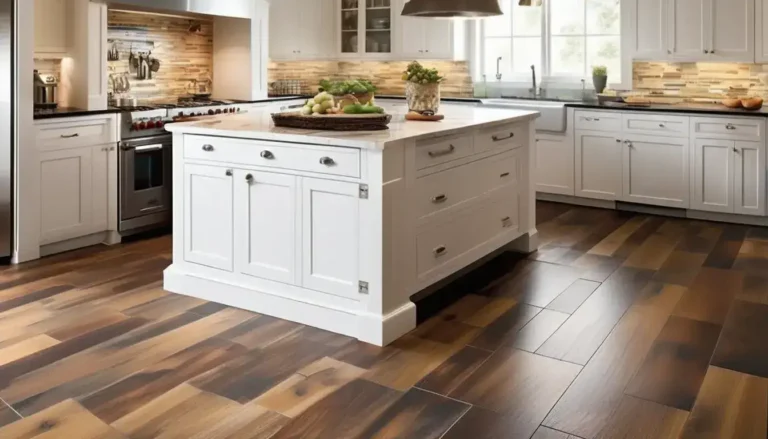
If you want your floor transition to make a statement, try a bold contrast between tile and wood. Pair dark tiles with light wood, or opt for contrasting tile colors that stand out against the natural wood tones. This creates a distinct boundary that separates the two materials while adding depth and visual interest. Bold contrasts are especially effective in modern kitchens, where the focus is on clean lines and sharp contrasts.
The Decorative Pattern Transition
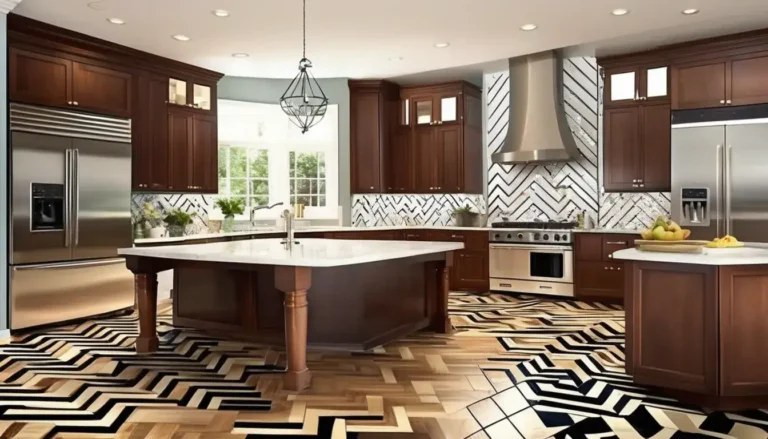
Incorporating a decorative border or patterned transition between the tile and wood adds a sophisticated touch to your kitchen. This could be a simple geometric pattern or a more intricate design that blends seamlessly with both materials. A decorative transition is especially great for those looking for a traditional or vintage-inspired look, adding a layer of elegance without overwhelming the space.
Tile Your Kitchen Island
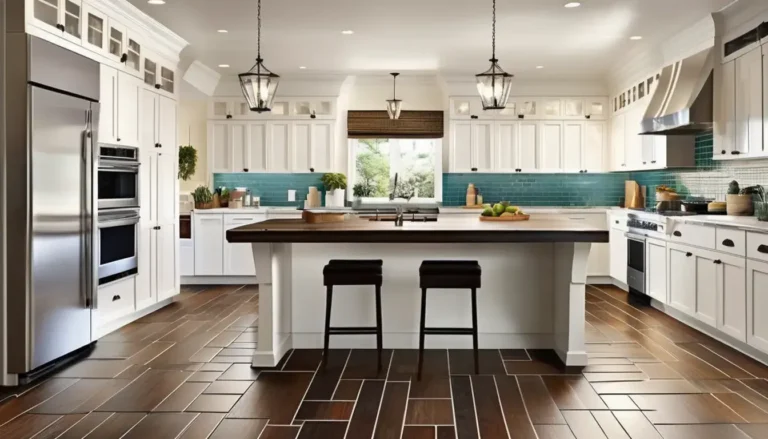
Extending the tile flooring underneath your kitchen island creates a defined transition from the tile floor to the wood around the rest of the room. This technique enhances the overall flow of the kitchen and keeps the design cohesive. The tile beneath the island can tie the entire kitchen together, offering consistency while allowing the rest of the floor to have its own distinct character.
Diamond Tile and Chevron Floor Plank Transition
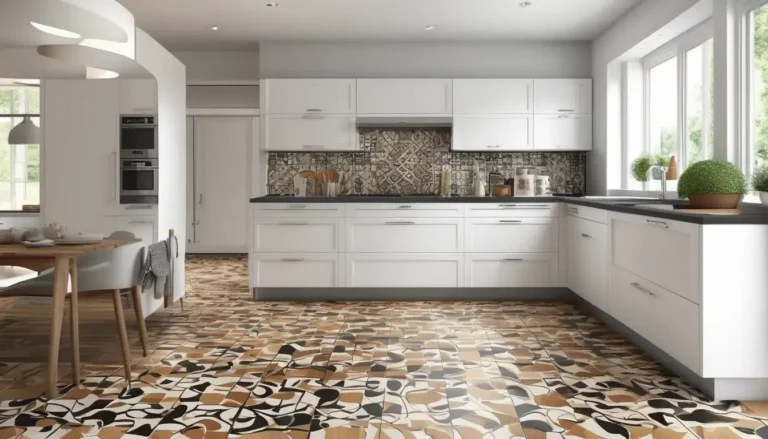
For a unique and striking look, combine diamond-shaped tiles with chevron wood planks for an ultra-modern, geometric transition. This combination creates an eye-catching visual flow, with the contrasting shapes and angles adding depth and texture. A diamond tile design pairs perfectly with the angular pattern of chevron wood, providing a bold transition that will stand out in any kitchen.
The Mixed Material Transition
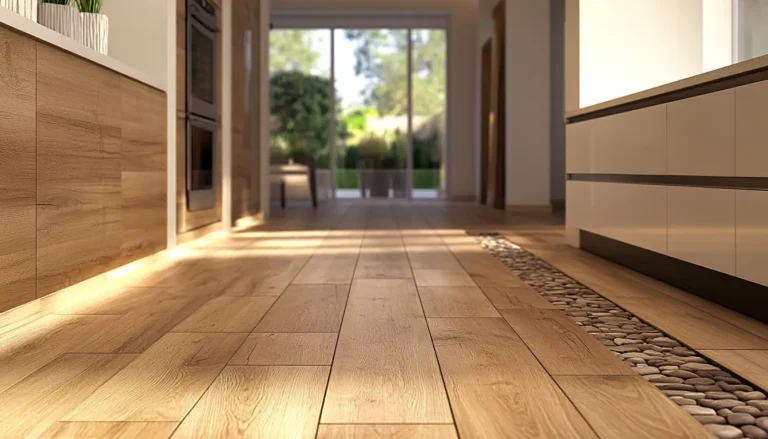
If you’re looking for a highly personalized touch, try mixing different materials along the transition line. For instance, combining stone, metal, or glass tiles with wood creates a unique fusion of textures that can’t be replicated with just one material. This mixed-material transition provides an artistic and modern look, offering a more eclectic feel to your kitchen while still maintaining the necessary functionality.
By incorporating these kitchen tile to wood floor transition ideas, you can create a smooth, stylish flow between your floors, ensuring that the tile and wood complement each other beautifully. Whether you opt for bold, eye-catching contrasts or a subtle, seamless blend, there’s a transition style for every kitchen design.
Benefits of Thoughtful Kitchen Floor Transitions
When considering kitchen tile to wood floor transition ideas, it’s important to understand the many advantages that a well-thought-out transition can bring to your kitchen. Not only does it enhance the overall aesthetics of the space, but it also plays a crucial role in the functionality and longevity of your flooring. Here’s how these transitions can elevate your kitchen:
Enhancing Functionality
Reducing Wear and Tear on Flooring Materials
A carefully chosen floor transition helps minimize direct wear and tear between the tile and wood areas. Proper transition strips and edging prevent tiles from chipping or wood from splintering, ensuring your floors remain durable over time.
Easy Maintenance with Appropriate Transitions
When the tile and wood are joined seamlessly, cleaning and maintenance become much easier. Transition strips and well-fitted edges prevent dirt and debris from accumulating, allowing for a smoother, more efficient cleaning process.
Adding Visual Appeal
Creating a Cohesive Design Flow
Kitchen tile to wood floor transition ideas can establish a smooth visual flow from one area to another, ensuring that both materials complement each other. Whether you choose a bold contrast or a subtle blend, the transition enhances the overall design, giving your kitchen a polished, cohesive look.
Highlighting the Transition Area as a Design Feature
Thoughtful transitions can serve as an intentional design feature. Whether you choose a striking geometric pattern or a simple, clean edge, highlighting the transition area can add character and sophistication to your kitchen.
Increasing Property Value
Well-Executed Transitions Reflect Professional Craftsmanship
A well-executed transition is often a sign of professional craftsmanship, and such attention to detail can significantly enhance the perceived value of your home. Clean, seamless transitions demonstrate quality work, adding a refined touch to your kitchen.
Makes Kitchens More Attractive to Potential Buyers
A kitchen with expertly designed floor transitions is more likely to attract potential buyers. The aesthetic appeal and functionality of the floor will leave a lasting impression, making your kitchen stand out in a competitive real estate market.
By integrating these kitchen tile to wood floor transition ideas, you’ll not only improve the functionality of your kitchen but also enhance its visual appeal and increase its market value. A smart floor transition is an investment in both style and long-term durability.
Final Thoughts
The top unique kitchen tile to wood floor transition ideas offer an exciting way to completely transform your kitchen. By focusing on both functionality and aesthetics, you can create a space that’s not only visually appealing but also durable and easy to maintain. Whether you choose bold contrasts, seamless blends, or intricate patterns, these transitions can enhance the flow of your kitchen and make it stand out.
At SF Marble & Granite, we specialize in providing high-quality flooring solutions that combine beauty and durability. If you’re ready to elevate your kitchen with the perfect tile to wood floor transition, contact us today to explore your options and get started on your project. Let us help you create a kitchen that blends style and practicality flawlessly!
FAQs
When it comes to kitchen tile to wood floor transition ideas, it’s natural to have questions about achieving the perfect look and ensuring the best results. Here are some common questions answered to guide you through the process:
How do I ensure a seamless tile to wood floor transition?
To achieve a seamless transition, use professional-grade transition strips and make sure to measure everything carefully. Precision in placement is key. Using quality materials that match the style of your kitchen can help the tile and wood merge smoothly, creating a clean, cohesive look.
Can I install tile-to-wood transitions myself?
While it’s possible to install tile to wood transitions yourself, it requires the right tools and patience for the best results. However, hiring professionals ensures a higher level of craftsmanship and can save you time and effort. They have the expertise to install the transitions perfectly, providing a flawless finish.
What are the best materials for kitchen transitions?
The best materials for kitchen transitions include metal strips for a modern look, decorative borders for an elegant touch, or grout-based solutions for a more subtle approach. Each material offers different benefits, so choosing one depends on your kitchen style and personal preference.

